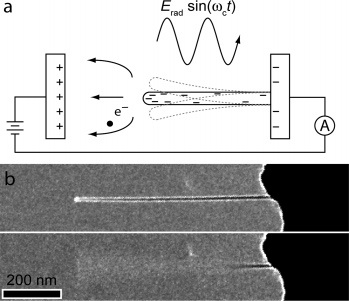Nanotube Radio for Communications and Medical Applications
APPLICATIONS OF TECHNOLOGY:- All-in-one radio receiver for cell phones/wireless networks/GPS and other electronic devices - Radio controlled devices that can exist inside the body, e.g. used as drug release triggers, diagnostic instrumentation, interfacing with muscle or brain function - Ultra small hearing aid - RF antenna, tunable pass filter, amplifier, or demodulator
ADVANTAGES:
- Orders of magnitude smaller than previous radios – can fit inside a living cell - Eliminates wiring/thermal problems associated with unifying a micro or nano-scale radio system - Extremely small power requirements - Can be tuned after fabrication and during operation - Can be manufactured individually or in arrays
ABSTRACT:
Alex Zettl and his team at Berkeley Lab have invented and constructed a fully functional, integrated radio receiver based on a single carbon nanotube (CNT). The nanotube serves simultaneously as all essential components of a radio: antenna, tunable band-pass filter, amplifier, and demodulator. The radio is several orders of magnitude smaller than previous radios and exploits the nanotube’s electro-mechanical movement, unlike conventional radios, which are electrical.
Berkeley Lab’s nanotube radio promises smaller, less complex, and lower power-requirement wireless communication devices. Because its scale is compatible with biological systems, the radio also offers unique opportunities for radio controlled devices to be placed in the body for various diagnostic, theraputic, monitoring, and sensory (auditory and visual) functions.
Using carrier waves in the commercially relevant 40-400 MHz range and both frequency and amplitude modulation (FM and AM), the Berkeley Lab team has demonstrated successful music and voice reception with the nanotube radio. After being received, filtered, amplified, and demodulated by the nanotube radio, the signal was further amplified by a current preamplifier, sent to an audio loudspeaker and recorded. Click here to listen to the recordings and see the radio in operation.
The Berkeley Lab nanotube radio consists of an individual CNT mounted to an electrode in close proximity to a counter electrode. Both the electrodes and nanotube are in a vacuum, typically below 10 -7 Torr. A direct current voltage (dc) source, such as from a battery or solar cell array, is connected to the electrodes and powers the radio. The dc voltage negatively charges the tip of the nanotube, tensioning it as desired to tune into oscillating electric fields. Thus the radio can be tuned while in operation to receive only a preselected band of the electromagnetic spectrum.
Amplification and demodulating properties arise from the needle-point geometry of the CNTs, which gives them unique field emission properties. By concentrating the electric field of the DC bias voltage applied across the electrodes, the nanotube radio produces a field emission current that is sensitive to the nanotube’s mechanical vibrations. Since the field emission current is generated by the external power source, amplification of the radio is possible. Furthermore, since field emission is a non-linear process, it also acts to demodulate an AM or FM radio signal, just like the diode used in traditional radios.
Attached files:

Inventor(s): Alex Zettl
Type of Offer: Licensing
« More Medical Devices Patents
« More Nanotech Patents
